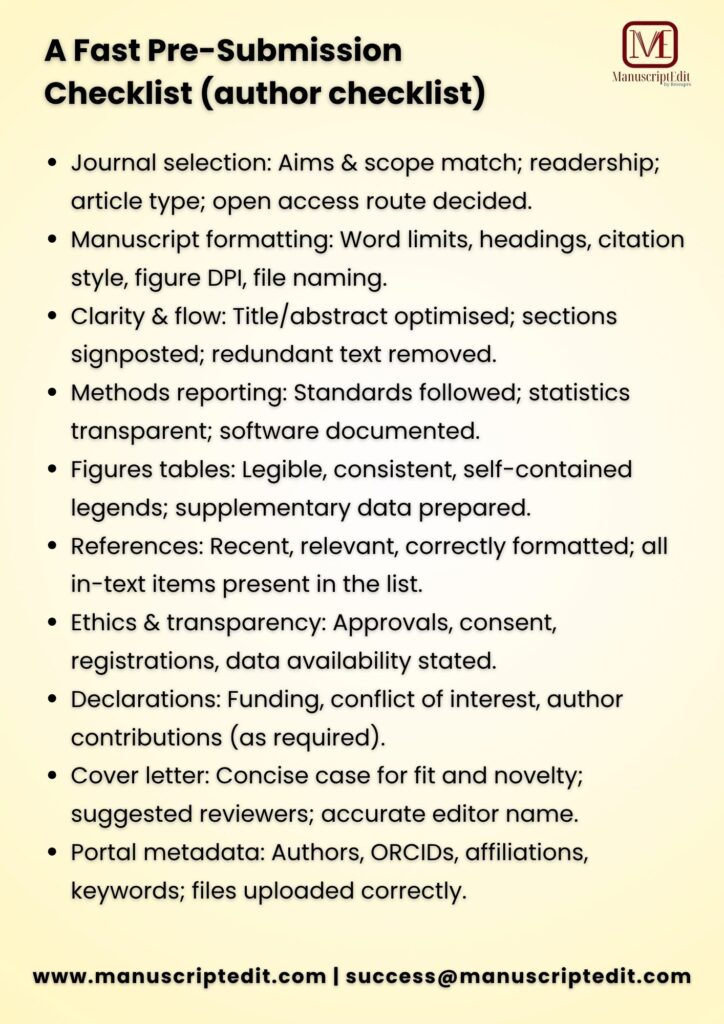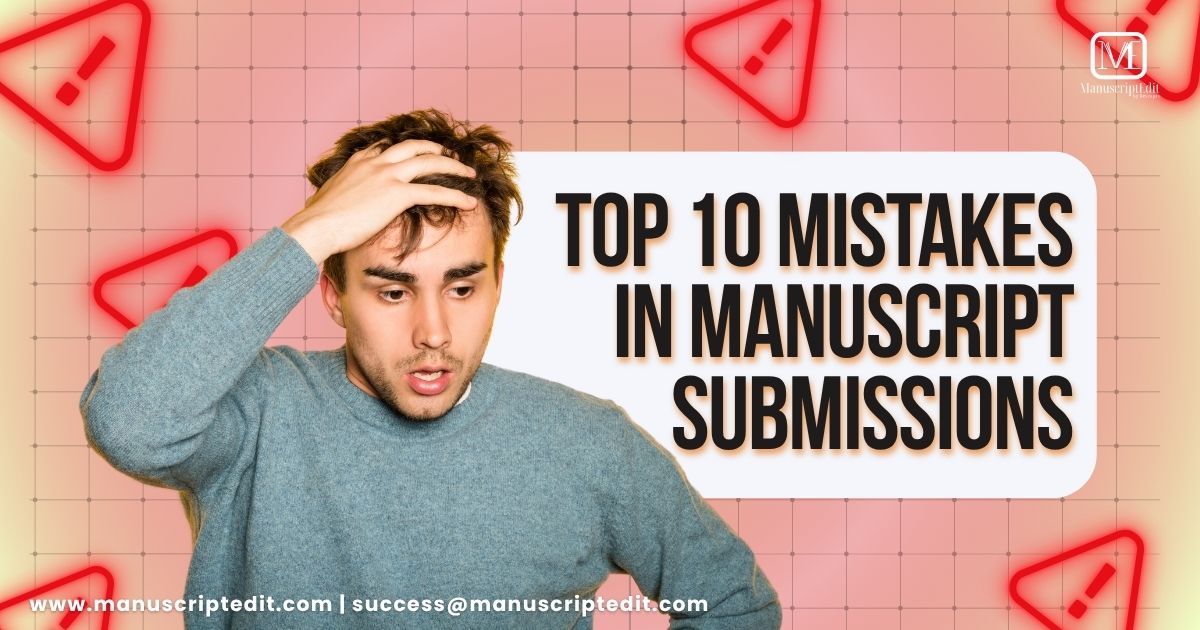Introduction
You’ve spent months (or years) generating results, but the success of your manuscript hinges on how well you submit it. Across thousands of journal submission cycles, the same issues repeatedly derail authors: mismatched journals, unclear writing, inconsistent formatting, thin methods, and weak responses to reviewer comments. This guide distils the top 10 submission mistakes we see—and how to fix them fast. Throughout, we emphasise a balanced approach: human expertise supported by smart tools (reference managers, grammar checkers, plagiarism checks) used transparently and responsibly.
Table of Contents
1) Submitting to the wrong journal (poor journal selection)
Why it hurts: Even strong studies face desk rejection if the topic, methods, scope, or readership don’t fit a journal. Misalignment wastes weeks and dampens momentum.
Fix it:
– Map journal selection to your study’s aim, methods, and typical article types.
– Scan recent issues; check acceptance policies, turnaround times, and open access options.
– Shortlist three journals ranked by fit, not just impact factor.
2) Ignoring author guidelines (formatting errors)
Why it hurts: Editors triage quickly. Formatting errors, missing declarations, incorrect citation style, and non-compliant word counts signal avoidable sloppiness.
Fix it:
– Build an author checklist from the target journal’s instructions (article type, word limits, reference style, figure resolution, data statements).
– Use a style sheet in your document.
– Run a pre-submission plagiarism check (with ethical settings) and a final template audit.
3) Weak title and abstract (low discoverability)
Why it hurts: Your title/abstract determine editor triage, reviewer interest, and search visibility. Vague claims or keyword-poor abstracts shrink reach.
Fix it:
– Craft a specific, accurate title with field-relevant phrases (e.g., “cohort study,” “randomised trial,” “systematic review”).
– In the abstract, use a clear structure: background → objective → methods → key results → implications.
– Thread in primary keywords naturally.
4) Poor structure and flow (English editing only at surface level)
Why it hurts: Crisp English is essential, but logic wins. Many papers read like note compilations: unclear narrative arc, repetitive text, orphaned claims.
Fix it:
– Outline each section’s objective.
– Use signposting (“We hypothesised…”, “We observed…”, “This implies…”).
– Ask an experienced colleague (or academic editing expert) to review argument flow, not just grammar.
5) Gaps in methods reporting (replicability issues)
Why it hurts: Thin protocols, missing sample size justification, unclear inclusion criteria, or incomplete statistical details trigger reviewer doubts—even if results look promising.
Fix it:
– Follow discipline standards (e.g., CONSORT, PRISMA, STROBE, ARRIVE).
– Detail recruitment, instruments, outcomes, analysis plans, and sensitivity checks.
– Include software versions, packages, and parameter settings.
6) Low-quality figures and tables (figures tables problems)
Why it hurts: Pixelated images, inconsistent labelling, and cramped tables reduce clarity and invite back-and-forth with production.
Fix it:
– Export at journal-required DPI with consistent fonts and axis units.
– Ensure figures tell a story (legend states what, how, and why it matters).
– Use tables for comparability; move bulk data to supplementary files.
7) Reference inconsistencies and weak literature positioning
Why it hurts: Reviewers notice when citations are outdated, mismatched to claims, or formatted incorrectly. Literature gaps undermine novelty.
Fix it:
– Update the last 24–36 months of manuscript citations where relevant.
– Align each major claim with a credible reference; avoid padding with tangential sources.
– Run a reference manager pass for citation style and cross-checks (in-text ↔ bibliography).
8) Ethics, transparency, and compliance mis-steps (publication ethics)
Why it hurts: Missing ethics approvals, data availability statements, conflict-of-interest disclosures, funding acknowledgements, or trial registrations can stall acceptance or trigger retractions.
Fix it:
– Include ethics board details, consent statements, and registration numbers where applicable.
– State data/code availability (repository links or justified restrictions).
– Provide complete funding and conflict-of-interest notes.
9) Sloppy cover letter and submission metadata (submission errors)
Why it hurts: The cover letter frames your work for the editor and signals professionalism. Weak summaries, generic language, or wrong editor names create a poor first impression.
Fix it:
– Address the editor by name; in 150–200 words, describe the novelty, audience fit, and any competing interests.
– Suggest suitable reviewers (and valid non-preferred reviewers with reason).
– Double-check submission portal fields: author names, affiliations, ORCID, keywords.
10) Mishandling revisions and reviewer comments (response letter problems)
Why it hurts: Many authors reply defensively or partially. A thin response letter risks another round of queries—or rejection.
Fix it:
– Create a point-by-point table: comment → response → manuscript change (page/line).
– Where you disagree, be courteous and evidence-based.
– Strengthen methods/detail where requested; avoid “cosmetic” tweaks only.
How to Use AI Responsibly—Without Losing Integrity
Smart support, never substitution. Tools can speed up English editing, reference formatting, or basic phrasing. But final decisions—what to claim, how to interpret results, where to submit—must remain human-led. Always disclose tool use when required by journal policies, and ensure a subject expert reviews every AI-touched section for accuracy, logic, and field conventions.
A Fast Pre-Submission Checklist (author checklist)

Final Thought
The difference between accept and revise/reject is often process, not prestige. Choose the right home for your study, follow the journal’s rules ruthlessly, make your story easy to read, and treat reviewers as collaborators. If you want a second set of expert eyes—on journal submission, manuscript editing, or your response letter—our senior editors can help you tighten clarity, compliance, and credibility before you click “Submit”.
If you want Manuscriptedit’s to be your research publication partner, feel free to explore our services at www.manuscriptedit.com
Click Here to read more such interesting blogs.




